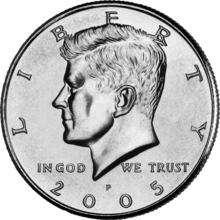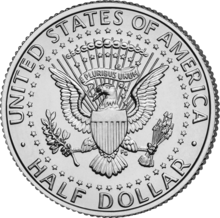Half dollar (United States coin)
United States | |
| Value | 0.5 U.S. dollar |
|---|---|
| Mass | 11.340 g (0.365 troy oz) |
| Diameter | 30.61 mm (1.205 in) |
| Thickness | 2.15 mm (0.085 in) |
| Edge | 150 reeds |
| Composition | 91.67% Cu 8.33% Ni |
| Years of minting | 1794–present |
| Catalog number | - |
| Obverse | |
 | |
| Design | John F. Kennedy |
| Designer | Gilroy Roberts |
| Design date | 1964 |
| Reverse | |
 | |
| Design | Presidential Seal |
| Designer | Frank Gasparro |
| Design date | 1964 |
Half dollar coins of the United States have been produced nearly every year since the inception of the United States Mint in 1794. Sometimes referred to as the fifty-cent piece, the only U.S. coin that has been minted more consistently is the cent.
Circulation
Half dollar coins are commonly used in casinos; rolls of half dollars are kept on hand in cardrooms in the United States for games requiring 50-cent antes or bring-in bets, for dealers to pay winning naturals in blackjack, or where the house collects a rake in increments of 50 cents (usually in low-limit seven-card stud and its variants). Many slot machines also took in, and paid out in, 50-cent pieces; however, casinos in recent years have phased in "coinless" slots for all denominations, taking in paper dollars, and paying winners through vouchers.
The half dollar's circulation, aside from use in some casinos and movie theaters, has declined significantly. The value of silver had risen by the early 1960s to the point that it became worthwhile to melt down U.S. coins for their bullion value. U.S. Silver coins (those of 10-cent value and above, which contained 90 percent silver through 1964) began to disappear from circulation, leading the United States to change to layered composition coins made of a copper core laminated between two cupro-nickel outer faces for the 1965 - present coinage years. The Kennedy half-dollar design, however, continued to be minted in a 40 percent silver-clad composition from 1965–1970. To find the value of a half-dollar, multiply the current market price for silver by 0.36169 for 1964 issues, and by 0.1479 for all issues 1965 to 1970.
Initially the Kennedy halves were hoarded for sentimental reasons and because they were recognized as the only precious metal U.S. coin remaining in circulation. By the time mintage figures could match normal demand and the coin's composition was changed to match the newer dimes and quarters in 1971, both businesses and the public had adapted to a world in which the half dollar did not generally circulate. Other uses had been found for the half-dollar section of the cash drawer. People had gotten used to depending on quarters as the major component of change.
Most coins enter circulation through the change drawers of businesses. Hardly any businesses stock their change drawers with half dollars or dollar coins, and many banks do not stock these coins or hand them out as normal business practice, so the coins do not see much circulation.
Most vending machines in the United States do not accept half dollars which further curtails its circulation. However, American sleight of hand magicians specializing in coin magic prefer the half dollar for its size and weight, and the most common denomination used for United States Commemorative Coins.
Today half dollars are minted only for collectors, with production for use by the Federal Reserve ceasing in 2001 due to lack of demand. Thus, all issues since 2001 have had much lower mintages than in previous years. Half dollars can be purchased in proof sets, mint sets, rolls, and bags from the U.S. Mint. Although intended only for collectors, these post-2001 half dollars sometimes are found in circulation.
History
- On December 1, 1794 the first half dollars (approximately 5,300 pieces) – were delivered. Another 18,000 were produced in January 1795 but these coins were produced with a die of 1794, because dies were too expensive to throw out because of the date.[1]
- Due to the high production of half dollars from the 1790s, another 30,000 pieces were struck by the end of 1801. The coin had the Heraldic Eagle, based on the Great Seal of the United States on the reverse.[1]
- One of the great mysteries of half dollars was the 150,000 that were minted in 1804 without one specimen known to exist. The coinage of 1804 was struck with dies from 1803, accounting for the confusion.[1]
- In 1838, half dollar dies were sent to a branch mint for the first time. The dies were sent to New Orleans and in 1839, the New Orleans Mint struck nearly 180,000 half dollars.[1]
Designs
|
|
References
- ^ a b c d Julian, R.W. (2006). "All About the Half Dollar". Numismatist Magazine. 119 (12): 38.
{{cite journal}}:|access-date=requires|url=(help); Cite has empty unknown parameter:|coauthors=(help); Unknown parameter|month=ignored (help) - ^ NGC Photo Proof (1994). "1794-95 Half Dollar Flowing Hair". CoinSite. ROKO Design Group, Inc. Retrieved 2009-03-13.
- ^ NGC Photo Proof (1994). "1796-97 Half Dollar Draped Bust Small Eagle". CoinSite. ROKO Design Group, Inc. Retrieved 2009-03-13.
- ^ NGC Photo Proof (1994). "1801-07 Half Dollar Draped Bust Heraldic Eagle". CoinSite. ROKO Design Group, Inc. Retrieved 2009-03-13.
- ^ NGC Photo Proof (1994). "1807-36 Half Dollar Capped Bust Lettered Edge". CoinSite. ROKO Design Group, Inc. Retrieved 2009-03-13.
- ^ NGC Photo Proof (1994). "1836-39 Half Dollar Capped Bust Reeded Edge". CoinSite. ROKO Design Group, Inc. Retrieved 2009-03-13.
- ^ NGC Photo Proof (1994). "1839-66 Half Dollar Seated Liberty No Motto". CoinSite. ROKO Design Group, Inc. Retrieved 2009-03-13.
- ^ NGC Photo Proof (1994). "1866-91 Half Dollar Seated Liberty With Motto". CoinSite. ROKO Design Group, Inc. Retrieved 2009-03-13.
- ^ NGC Photo Proof (1994). "1892-1915 Half Dollar Barber". CoinSite. ROKO Design Group, Inc. Retrieved 2009-03-13.
- ^ NGC Photo Proof (1994). "1916-47 Half Dollar Walking Liberty". CoinSite. ROKO Design Group, Inc. Retrieved 2009-03-13.
- ^ NGC Photo Proof (1994). "1948-63 Half Dollar Franklin". CoinSite. ROKO Design Group, Inc. Retrieved 2009-03-13.
- ^ NGC Photo Proof (1994). "1964- Half Dollar Kennedy". CoinSite. ROKO Design Group, Inc. Retrieved 2009-03-13.
External links
- United States Half Dollars at American Coin Online
- Kennedy Half Dollars at CoinFacts.com
